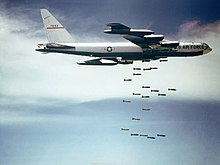Raven FAC

Raven FAC or Raven Forward Air Controllers were the names of US Air Force pilots who were deployed on a secret mission in the Kingdom of Laos during the Vietnam War . They carried out forward air controller missions on behalf of the US Embassy in Vientiane . The operation was named Palace Dog , Embassy Internal Project 404 . The pilots used Raven ( Raven ) as its radio call sign . They were primarily used by General Vang Pao in Long Cheng . Long Cheng was a secret base surrounded by high mountains and the headquarters of the Hmong fighters or rebels. These fighters were financed, supplied and trained by the American secret service CIA . The Raven also had smaller bases in Vientiane, Pakse , Savannakhet and Luang Prabang . They coordinated and controlled the area bombing by the US Air Force over northern Laos, mostly close air support missions against units of the Pathet Lao and regular units of North Vietnam .
The Raven program was officially launched on May 5, 1966. The last of the Raven left the country in May 1975 after the conquest of Long Cheng by communist units. The Raven had the highest casualty rate of American forces in the Vietnam War at 30%. Of the pilots deployed, 60 percent were shot down at least once by enemy air defense.
Officially, the pilots were civilians and employees of the aid organization USAID , since the Treaty on the Neutrality of Laos (English: International Agreement on the Neutrality of Laos), signed on July 23, 1962 in Geneva , did not allow American bases in Laos. The aircraft used were officially their private property, but were serviced at the American base in Udon in Thailand . The aircraft had officially been taken out of service by the Air Force. In contrast to the picture shown, they were not marked with the US Air Force.
There were never more than 22 ravens at the same time. They marked targets for the approaching bombers with target marker missiles , kept radio contact with them and then assessed the success of the bombing. The radio operator in the back seat had the task of maintaining radio contact with the units on the ground that were setting the targets of the bomber attacks.
The bombers themselves were not stationed in Laos. They flew to Thailand, Vietnam and Guam. In addition to B-52 bombers, fast combat aircraft were used, which also took off from aircraft carriers .
In addition to the Raven, there were other FAC programs. These were CIA units deployed by the US Embassy in Vientiane, so-called Road Watcher Teams , and special units of the Military Assistance Command Vietnam (MACV), the so-called Studies and Observation Group , see MACV-SOG . These coordinated bombing raids over the Ho Chi Minh Trail , a network of supply links between North and South Vietnam that ran through Laotian territory, and must not be confused with the Raven, who primarily intervened in the Lao civil war .
In the early years of the American secret war in Laos, planes, helicopters and pilots from the CIA's own airline Air America were also used for FAC missions. As members of the Air Force, the Raven coordinated the operations of the bombers and were co-pilots. Often an additional Thai or Laotian observer was on board who kept contact with the ground troops.
In addition to the American air force, the Lao government and the Hmong rebels also had their own air forces. Mostly North American T-28s were used for close air support. The Raven also used these machines occasionally. Usually these machines were flown by Laotian pilots who had received training in Udon Thani , Thailand . This training program, conducted by the US Air Force and funded by the CIA, was code-named Waterpump . The Laotian pilots also carried out FAC missions.
literature
- Robbins, Christopher (1987) The Ravens: The Men Who Flew in America's Secret War in Laos. Crown, ISBN 0-517-56612-5 , ISBN 978-0-517-56612-1
- George Marrett Cheating Death: Combat Rescues in Vietnam and Laos
- Eugene D. Rossel Usaf Air Commando Secret Wars from Laos to Latin America
Web links
- Veteran site of the Raven
- Ravens of Long Tieng In the remote highlands of Laos, US Air Force pilots fought a secret war
Individual evidence
- ↑ Eugene D. Rossel: Usaf Air Commando - Secret Wars from Laos to Latin America

